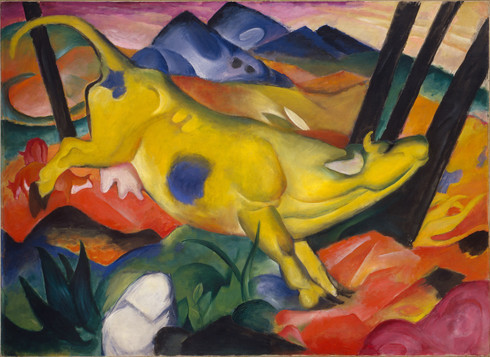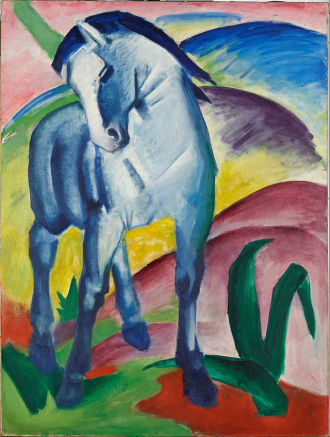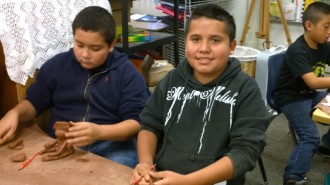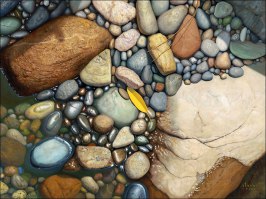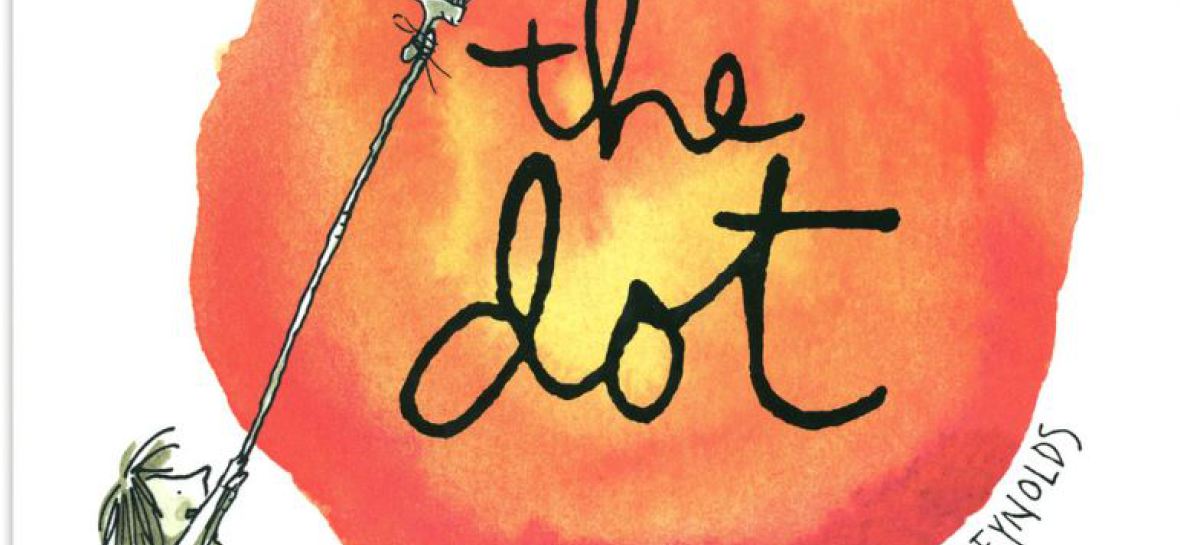

- I am an Artist; Arranging Stones
- Nature of Line Painting with Water
- I am Line; Drawing in Sand
- Oh, to be a Dog!
- The Cat's Pajamas
- Artists in School:Arranging Flowers
- Artists at Home
- Down on the Farm
- Pumpkin Patch Fun
- Leaf Printing
- Owl Babies
- Thanksgiving
- Gingerbread man
- Snowy Day
- Shadows
- Imagine a Miro
- Paint the Sky
- Spring has Sprung
- Blossoms and Bees
- The Hatching
- Snail Spells & Spirals
Creating an Abstract Farm Animal
Have you ever been to a farm? Have you ever petted a farm animal?
Well Let's Visit the Farm!
Activate prior knowledge related to the information and events in texts.
View the Art
Did you see the cow and horse on the farm? What did they look like?
Let's look at some animals painted by a group of artists called "Blue Rider."
The name Blaue Reiter (“blue rider”) refers to the horse and rider, which was for Vasily Kandinsky a symbol for moving beyond looking realistic to make believe.Kandinsky and Franz Marc, both loved painting animals. Do these look like the ones on the farm? What makes you say that?
Key Ideas and Details
? With prompting and support ask and answer questions about key details in the art. What do you see in the painting? What makes you say that? What else do you notice in the art?
Where is the character? What makes you think that? What are 2 more things you notice in the setting?
? What are the colors Franz Mark used that would make you think of warm sun or fire? What are the colors he used that would make you think of cool water or shadey trees? So what did he make happen by using contrasting those warm and cool colors?
? What lines do you see, and where are they?
What shapes do you see?
Do you see any shapes or lines that repeat/copycat each other?
How do you think this animal would feel?
Have Kindrs use dry erase markers and boards. As they scan the art they can draw a geometric shape after they've identified it in the art work. Its a teachable moment to discuss each shapes attributes.
Integration of Knoweldge
? Do you think Frans Marc was trying to show a real animal in a real place or make believe?
Create the Art
1. Using a marker on construction paper, students draw and combine geometric shapes to create their farm animal. Encourage them to use a variety of shapes they are familiar with.
2. Once the animals have been drawn, have students color in their shapes using multiple colors.
3. Encourage students to use simple geometric shapes to create a background habitat for their animals. It can be as imaginative as they wish.
Assessment
4. Provide class time for students to talk about the various animals pictured by classmates. I found that if they share first in groups of two then four they talk more about their art.
5. At the end of class we make a circle and stand holding our art "Museum in the Round." Each child says one thing about their work or experience.
Extending the Art Lesson
With prompting and support compare and contrast the adventures and experiencces of those animals in the art works with the animals in stories or nursery rhymes.
Phonics and Word Recognition
Recognize and produce rhyming words
Let's look at 2 videos, both about farm animals. How are they similar or different from Franz Marc's animals?
Create a new drawing of a farm animal doing something exciting! What sound would your animal be making as it moves?
Compare your two works, which one is better and why?
Cafe Art 4 Point Rubric
C - Create, A-Articulate, F-Find Real World Connections and Reslationships, E- Evaluate
1 Does not Meet 2 Almost Meets 3 Meets 4 Exceeds
|
1 |
2 |
3 |
4 |
|
Images not clearly defined Places unidentifiable symbols randomly on paper
|
Sometimes creates visually recognizable images
Uses recognizable symbols on paper unrelated to directions |
Creates visually recognizable images
Follows specific directions with some guidance |
Develops own appropriate images; uses color in thoughtful ways
Able to work on specific assignments independently
|
|
Does not speak audibly. Egocentric focus during meetings or discussions |
Able to speak somewhat audibly and makes some appropriate comments during meetings or discussions
|
Able to speak audibly and talk about own work; listens to the comments of others
|
Able to speak audibly and talk about what is seen in other artists’ work |
|
Non-focused experimentation with tools and media |
Beginning to control media and tools; puts them away with help |
Is in control of media and puts tools and materials away with reminders |
Treats tools and media safely and with respect; cleans up without being reminded.
|
|
Only evaluates art according to “I like it.” “It is pretty.” |
Beginning to think critically about their art, and may give a simple reason they think their art is successful or not. But with guidance or support they can’t go beyond that one reason
|
Able to evaluate their art according to development and organization and decide if their work is successful or not with some guidance, giving two reasons. “I like my art because I drew my cow realistically.” My cow is beautiful because I used warm colors.” |
Able to evaluate their art according to development and organization and decide if their work is successful or not. I like my art because I used my imagination to color the cow, and I like the shapes I drew because my cow looks like a real cow. |
Lesson Objectives
- LA: Participate in collaborative conversations with diverse partners about grade level topics and texts with peers and adults in small or larger groups.
- LA: With guidance and support from adults, focus on a topic, respond to questions and suggestions from peers, and add details to strengthen writing as needed.
- LA: Use a combination of drawing, dictating, and writing to compose informative/explanatory texts in which they name what they are writing about and supply some information about the topic.
- LA: Create audio recordings of stories or poems; add drawings or other visual displays to stories or recounts of experiences when appropriate to clarify ideas, thoughts, and feelings.
- MATH: Recognize and draw shapes having specified attributes.
- MATH: Understand that shapes in different categories may share attributes, and that the shared attributes can define a larger category.
- SCI: Ask questions about the natural and human-built worlds.
- VA: Use art materials and tools in a safe and responsible manner.
- VA: Select and use subject matter, symbols, and ideas to communicate meaning
Artful Teaching
Mrs. Schellenberg & Young Artists
Ralph Waldo Emerson's Poem: Success- to leave the world a bit better, whether by a healthy child, a garden patch or a redeemed social condition; To know even one life breathed easier because of you.
Thank you AT&T
We used the wiring for our artful galimotos

